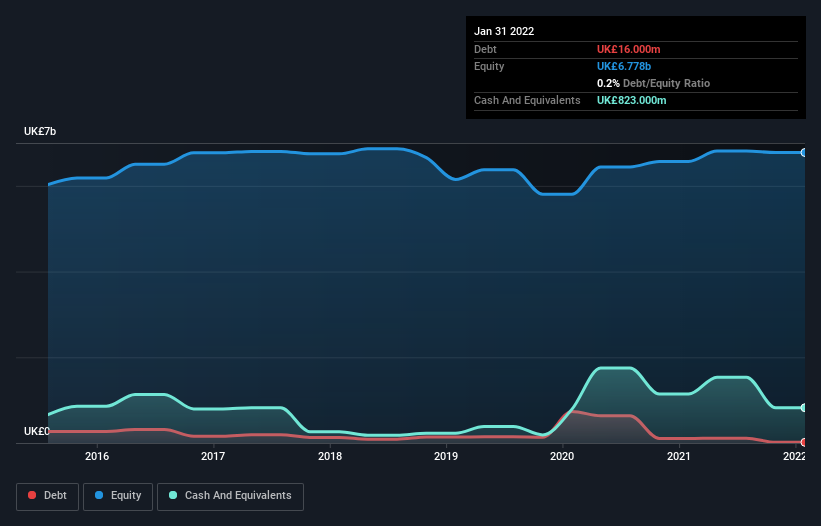We Think Kingfisher (LON:KGF) Can Stay On Top Of Its Debt
Howard Marks put it nicely when he said that, rather than worrying about share price volatility, 'The possibility of permanent loss is the risk I worry about... and every practical investor I know worries about.' When we think about how risky a company is, we always like to look at its use of debt, since debt overload can lead to ruin. As with many other companies Kingfisher plc (LON:KGF) makes use of debt. But is this debt a concern to shareholders?
When Is Debt A Problem?
Debt assists a business until the business has trouble paying it off, either with new capital or with free cash flow. Ultimately, if the company can't fulfill its legal obligations to repay debt, shareholders could walk away with nothing. However, a more common (but still painful) scenario is that it has to raise new equity capital at a low price, thus permanently diluting shareholders. By replacing dilution, though, debt can be an extremely good tool for businesses that need capital to invest in growth at high rates of return. When we think about a company's use of debt, we first look at cash and debt together.
Check out our latest analysis for Kingfisher
How Much Debt Does Kingfisher Carry?
The image below, which you can click on for greater detail, shows that Kingfisher had debt of UK£16.0m at the end of January 2022, a reduction from UK£104.0m over a year. However, it does have UK£823.0m in cash offsetting this, leading to net cash of UK£807.0m.
How Strong Is Kingfisher's Balance Sheet?
We can see from the most recent balance sheet that Kingfisher had liabilities of UK£3.12b falling due within a year, and liabilities of UK£2.46b due beyond that. Offsetting these obligations, it had cash of UK£823.0m as well as receivables valued at UK£255.0m due within 12 months. So its liabilities outweigh the sum of its cash and (near-term) receivables by UK£4.50b.
This deficit is considerable relative to its market capitalization of UK£5.32b, so it does suggest shareholders should keep an eye on Kingfisher's use of debt. Should its lenders demand that it shore up the balance sheet, shareholders would likely face severe dilution. Despite its noteworthy liabilities, Kingfisher boasts net cash, so it's fair to say it does not have a heavy debt load!
Also good is that Kingfisher grew its EBIT at 16% over the last year, further increasing its ability to manage debt. There's no doubt that we learn most about debt from the balance sheet. But it is future earnings, more than anything, that will determine Kingfisher's ability to maintain a healthy balance sheet going forward. So if you want to see what the professionals think, you might find this free report on analyst profit forecasts to be interesting.
Finally, a company can only pay off debt with cold hard cash, not accounting profits. Kingfisher may have net cash on the balance sheet, but it is still interesting to look at how well the business converts its earnings before interest and tax (EBIT) to free cash flow, because that will influence both its need for, and its capacity to manage debt. Over the last three years, Kingfisher recorded free cash flow worth a fulsome 98% of its EBIT, which is stronger than we'd usually expect. That puts it in a very strong position to pay down debt.
Summing up
Although Kingfisher's balance sheet isn't particularly strong, due to the total liabilities, it is clearly positive to see that it has net cash of UK£807.0m. And it impressed us with free cash flow of UK£781m, being 98% of its EBIT. So we are not troubled with Kingfisher's debt use. When analysing debt levels, the balance sheet is the obvious place to start. But ultimately, every company can contain risks that exist outside of the balance sheet. To that end, you should learn about the 2 warning signs we've spotted with Kingfisher (including 1 which makes us a bit uncomfortable) .
If, after all that, you're more interested in a fast growing company with a rock-solid balance sheet, then check out our list of net cash growth stocks without delay.
Have feedback on this article? Concerned about the content? Get in touch with us directly. Alternatively, email editorial-team (at) simplywallst.com.
This article by Simply Wall St is general in nature. We provide commentary based on historical data and analyst forecasts only using an unbiased methodology and our articles are not intended to be financial advice. It does not constitute a recommendation to buy or sell any stock, and does not take account of your objectives, or your financial situation. We aim to bring you long-term focused analysis driven by fundamental data. Note that our analysis may not factor in the latest price-sensitive company announcements or qualitative material. Simply Wall St has no position in any stocks mentioned.

 Yahoo Finance
Yahoo Finance 
